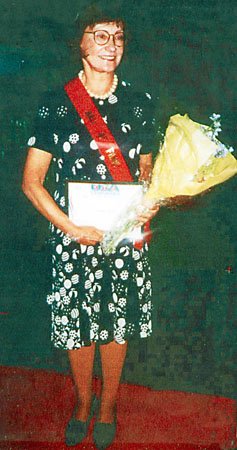|
ZABKA, Norma
|
| Prelude to Rhythmic Gymnastics
The history of Rhythmic Gymnastics can be traced as far back as 1814 by Per Henrik Ling. Ling promoted aesthetic gymnastics in which students expressed their feelings and emotions through bodily movement but it was still calisthenics without apparatus. Then it 1864 proponents of the activity began utilizing wooden hoops, light dumbbells, and Indian clubs. Indian clubs became a favorite exercise tool with entire books being written for club exercises. A rope was first used by a Swedish group around the 1930’s. The Hoop became more popular after a demonstration at the 1936 Olympic Games.
Ellen Nyemcsik was kind enough to also furnish the following: “The Floor event was called Exercise without Implement. It was a Rhythmic Gymnastics dance routine performed to music without using the apparatus. Exercise without Implement was part of FIG All Around competition years ago. But as the sport developed, the FIG eventually changed the program to 4 events using all 4 of the apparatus. All of our current USA Gymnastics Junior Olympic program competitors (in Levels 3-8) have this floor event as part of the regular All-Around competition today. Our USA gymnasts compete in the Floor event until they reach the FIG level (Levels 9-10). Then they compete only with the apparatus at these high levels.” http://eliterg.com/history.html (Elite RG.com) |
Norma Zabka is a U.S. Hall of Fame Inductee for her pioneer works in the development and progress of “Rhythmic Gymnastics” in the U.S. and for her services as a national and international judge. She has been a Sokal member since age four and currently serves as President of Sokol New York. Sokol new York is the legacy left to Yorkville by the 19th and 20th century Czech and Slovak immigrants, their children, and grand children, and maintained today by them working as volunteers. Sokol started in Prague in 1862. In 1865 the first USA Sokol was established in St. Louis and with New York following in 1867.
Olympic Games Rhythmic Judge: Los Angeles, (1984); Seoul, Korea, (1988), Barcelona, Spain, (1992), and Atlanta, Georgia, (1996). World Rhythmic Gymnastic Championships Judge: Madrid, Spain, (1975), Fort Worth, Texas, (1979); Munich, Germany, (1981); Strasbourg, France, (1983); Vallodolid, Spain, (1985); Sophia, Bulgaria, (1987); Sarajevo, Yugoslavia, (1989); Athens, Greece, (1991); & Indianapolis, USA, (1993). Pan American Games: Indianapolis, IN, (1987), Venezuela, (1987), Puerto Rico, (1988), Tallahassee, Florida, (1990), Havana, Cuba, (1991), Sao Paulo, Brazil, (1992), Monterrey, Mexico, (1994), & Guatemala, (1996). Olympic Sports Festivals: Olympic Festival, San Antonio, Texas, (1993), Los Angeles, (1991), Houston, Texas, (1986), North Carolina, (1987), Baton Rouge, Louisiana, (1985), & Colorado Springs, Colorado, (1983). Rhythmic National Championships: Olympic Training Center, Colorado, (1992), Nassau County, New York, (1992), Athens, Georgia, (1996), Houston, Texas, (1997), & Colorado Springs, Colorado, (1993). Olympic Trials: Salt Lake City, Utah, (1988), Baltimore, Maryland, (1992), Boston, Massachusetts, (1996), & New York, New York, (1964). Service To Rhythmic Gymnastics: Charter member of USA Rhythmic Gymnastics Committee and served as Chairperson; Editor of AAHPERD-Division of Girls’ and Women’s Sports Gymnastic Guide; Norma has authored numerous gymnastic articles and co-authored Gymnastic Activities with Hand Apparatus for Girls and Boys” with Marie Provaznik. Norma was the USA delegate to the FIG Congress, Rome, Italy, (1986) & Atlanta, Georgia, (1996). She was a significant person in the development and progression of Artistic Gymnastics in the U.S. and influenced the sport’s development in foreign countries as well. During the 1970’s, she became a Federation of International Gymnastics (FIG) judge Brevet for rhythmic and a member of USA Gymnastrada, Denmark, (1980’s). Norma served on the USAG’s Rhythmic Gymnastics Committee where she was rated a “Brevet Judge”. Norma also served as Chairman of the Pan American Rhythmic Gymnastics Committee, Chairman of the USAG Rhythmic Gymnastics Committee, and Vice-president of USA Gymnastics. She has served as a judge at events throughout Europe, North America, Central America, Cuba, South America, Korea, Japan, Australia, and New Zealand.Personal: In keeping with family tradition, Norma Zabka has been a Sokol member since childhood. She won gold in the Jr. National Amateur Athletic Union (AAU) championships in the 1940’s. She is also an American Sokol National Gymnastics Champion. Norma was an attendee at the original Sokal Barryville camp for the new to the U.S. “Rhythmic Gymnastics”. Trainers and attendees at this camp branched off, and they started classes or camps for developing athletes in rhythmic gymnastics. After graduating from NYU and completing a Master’s Degree at Hunter College, Norma began classes at Hunter College in New York City where she taught and progressed to Associate Professor. She is now retired.
Sources: Gratitude is expressed to Norma Zabka for the interview time she gave so graciously. Thanks are also due Jerry Wright, author of Gymnastics Who’s Who, 2005, and Ed Chlanda of the New York Sokol office for information about Ms. Zabka and the Sokol history. Rhythmic gymnastics paraphrasing courtesy of olympic/uk/sports. Introduction, commentary, and formatting by Dr. Larry Banner, Web Manager.
|
|
|

